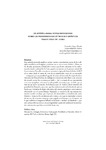De Aviñón a Roma: nuevas reflexiones sobre las transferencias litúrgicas y artísticas tras el final del Cisma

View/Open
Use this link to cite
http://hdl.handle.net/2183/20277
Except where otherwise noted, this item's license is described as Creative Commons Reconocimiento-NoComercial 4.0 Internacional.
Collections
- Investigación (FHUM) [116]
Metadata
Show full item recordTitle
De Aviñón a Roma: nuevas reflexiones sobre las transferencias litúrgicas y artísticas tras el final del CismaAuthor(s)
Date
2017Citation
LÓPEZ MAYÁN, Mercedes. De Aviñón a Roma: nuevas reflexiones sobre las transferencias litúrgicas y artísticas tras el final del Cisma. Medievalia, [S.l.], v. 20, n. 1, p. 161-195, dic. 2017
Abstract
[Resumen] Este artículo pretende ampliar y revisar nuestro conocimiento acerca de las múltiples transferencias litúrgicas y artísticas que se dieron entre Aviñón y Roma en las décadas posteriores al final del Cisma y que fueron decisivas en la conformación ritual y cultural de la Curia papal y su entorno en la primera mitad del Cuatrocientos. Para ello, examina un manuscrito ignorado hasta la fecha: el BCT 56-23, tanto desde el punto de vista de su materialidad como de su contenido –compuesto por un pontifical seguido de varias adiciones (la Descriptio basilicae Vaticanae de Petrus Mallius, las Indulgentie ecclesiarum urbis Rome y un proyecto de cruzada contra los otomanos en 1458)–. Así, y a través de su comparación con otros ejemplares próximos, ha sido posible determinar, por un lado, que se trata de un nuevo testimonio de la llamada por M. Andrieu forme remaniée del pontifical de Durando y, por otro, que fue confeccionado en la década de 1430 en Basilea por iniciativa de algún eclesiástico del entorno papal pero estrechamente relacionado con el sureste francés. Siguiendo la trayectoria de este manuscrito, nuestro estudio concluye que el proceso de intercambios y transferencias entre Aviñón y Roma no fue unidireccional ni único, sino que se materializó a través de una red de contactos compleja y prolongada en el tiempo y en el espacio, en la que también se integraron influencias foráneas –incluso neerlandesas–, que solo será posible reconstruir en su integralidad a partir del análisis de los testimonios manuscritos que han sobrevivido hasta hoy. [Abstract]This article aims to extend and review our knowledge about the liturgical and artistic transfers that occurred between Avignon and Rome in the decades following the end of the Schism and that were decisive in the ritual and cultural configuration of the Papal Curia and its entourage in the first half of the 15th century. To that purpose, I examine a manuscript ignored to date: the BCT 56-23, both from a material and a textual point of view –it contains a pontifical followed by several additions (the Descriptio basilicae Vaticanae by Mallius Petrus, the Indulgentie ecclesiarum urbis Rome and some notes for a crusading project against the Ottoman Empire in 1458)–. By doing so, and through its comparison with other similar manuscripts, it has been possible to determine, firstly, that this codex can be fully related to the so-called forme remaniée (M. Andrieu) of the Durandus pontifical; and, secondly, that it was made in Basel around the 1430’s commissioned by a clergyman belonging to the papal entourage but also closely connected to the French southeast. Following the path of this manuscript, my study concludes that the process of exchanges and transfers between Avignon and Rome after the Schism was not unidirectional or unique, but took the form of a network of complex contacts, prolonged in time and space, in which foreign influences –even from the Netherlands– also played a decisive role. But it will only be possible to reconstruct this process in its entirety from the analysis of manuscripts that have survive to date.
Keywords
Manuscrito
Liturgia
Miniatura
Curia papal
Pontifical de Durando
Forme remaniée
BCT 56-23
Aviñón
Roma
Manuscript
Liturgy
Papal curia
Durandus Pontificial
Avignon
Rome
Liturgia
Miniatura
Curia papal
Pontifical de Durando
Forme remaniée
BCT 56-23
Aviñón
Roma
Manuscript
Liturgy
Papal curia
Durandus Pontificial
Avignon
Rome
Editor version
Rights
Creative Commons Reconocimiento-NoComercial 4.0 Internacional.
ISSN
2014-8410






